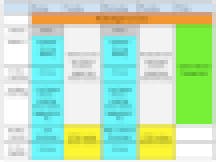A few years ago, we wrote an article for EdSurge about our school, Taos Academy, and its personalized learning model, focused on flexible weekly scheduling. In that model, students come to campus a few days a week and learn online the rest of the time—not unlike what many schools are experimenting with these days. Through tailoring schedules to meet the needs of our students and their families, we’ve been able to increase engagement and encourage ownership of learning. We ended that article with a Spiderman reference: “With great power, comes great responsibility.”
However, Taos Academy’s learning model, like that of many schools, underwent a real time stress test in the spring with our sudden shift to emergency remote teaching and learning. The past few months have shown us the true extent of the flexibility and resilience of our model as we plan for students to return after summer break, both virtually and eventually in small groups on campus, as well as design wraparound supports across a variety of formats.
Usually at this time of year we love walking through our classrooms, seeing students creating digital artwork, plotting their growth toward mastery and collaborating with friends—but today, our campus stands mostly empty. Teachers and students are meeting in the cloud and our school has opened in a fully virtual model for the start of the school year with the expectation of a slow reentry by the end of the first quarter. With the uncertainty of scheduling in the time of COVID-19, we have created plans for as many scenarios as we can in order to ensure continuity of learning.
The truth is, we weren’t designing for a pandemic when we created this school as an innovative way to serve at-risk students in the mountains of rural northern New Mexico. But what we designed 12 years ago, and what the school has grown into, has proven to be more resilient than we could have imagined. Here’s a look at our evolution, and what other schools can learn from our journey.
Personalized Student Schedules: The Foundation
In our model, students and families are given the freedom to choose the schedule that works best for their needs. Pre-COVID-19, our “default setting” schedule had students join us on campus two days a week; middle school students attending Mondays and Wednesdays and high schoolers on Tuesdays and Thursdays. These face-to-face classes provide a counterpoint to the flexibility and independence of the digital core curriculum, where subjects like math and language arts are taught, which allows students to apply what they learn online in collaborative, project-based learning experiences. Their time on campus helps tether them to our school community and gives them the chance to meet with advisors and make friends.
Since students do not take core classes on campus, the basic building blocks of the in-person schedule include:
- Advisory Class: The student-advisor relationship is one of the foundational pieces of our school. The advisor is responsible for overseeing a group of up to 20 students and their academic success and connecting them to any supports they might need. During advisory, students learn many of the “soft skills” needed to become empowered learners—they set weekly goals, celebrate successes, create class norms and culture, practice social-emotional learning strategies and become a learning community.
- 21st-century Learning: All students rotate through a suite of classes, including a hands-on STEM class called SmartLab, as well as Global Studies, P.E./Wellness and Leadership in grade 5-9; high school students move on to Career Pathways, an internship course, seminars in the humanities and economics and dual credit opportunities.
- Enrichment Classes: These classes provide students with opportunities to supplement their digital curriculum with hands-on, collaborative learning and creative experiences with their content area teachers.
Sample Blended Learning Schedule Pre-COVID-19

Hybrid Learning Model: Small Group Setting
Our initial direction from our state’s education department as case numbers waned was to plan for reopening in a hybrid learning model. Naturally, our hybrid reentry model drew upon our usual blended learning plan, but with adjustments for health and safety guidelines, including:
- Small, socially distanced student groups
- Limited exposure by assigning 1-2 teachers for each learning group
- Groups remain in their “Home Base” learning environment with teachers moving, rather than students
- Use of outside spaces wherever possible
- Masking and hand sanitizing protocols
- Staggered drop off and pick up times
In this model, we moved most of our support systems and optional programming online, such as our STEM classes, which will be taught virtually, and reconfigured our Student Success Lab as “Homework Hotlines,” where students can access just-in-time tutoring via Google Meets. At the same time, in order to accommodate small groups with our limited staff, the advisory block occurs only once a day and we added learning support time to the on-campus schedule to promote targeted academic support.
Sample Hybrid Learning Schedule

Virtual Learning Model: A Rapid Transition
As the summer progressed and shelter in place orders were lifted in the state, case numbers in New Mexico spiked sharply in July, causing concern that we could be facing a second wave of COVID-19. Schools were directed to review their opening plans to start the school day in an entirely virtual setting with an eventual, gradual phase-in of students returning to campus after Labor Day.
While Taos Academy students would continue in their core digital curriculum as usual, the phased transition to our hybrid learning model would see younger students (fifth and sixth graders) returning to campus in their small group settings, followed by seventh and eighth grades two weeks later and eventually transitioning our high schoolers from at-home to on-campus, small-group learning. Thus, our virtual model needed to be both more rigorous than our emergency remote teaching in the spring and also more flexible to follow the gradual release guidelines.
In this virtual model, we worked to move the basic building blocks of instruction to the cloud: Students meet in real time with their Advisory and 21st-century classes on their regular days. Our Enrichment block was reconfigured to focus on individual support. During this time, content teachers are conducting one-on-one or small group mini-lessons or remediation using the data from student’s assignment and quiz scores to gauge where they need support. Our “Homework Hotlines” remained in place as an on-demand support for at-home learning and for working families; in addition, we added a Family Outreach team to ensure that all families receive direct communication by phone prior to the start of school and during our orientation weeks.
Sample Virtual Learning Schedule

Wrap-Around Programming
From our parent and student feedback so far, the virtual learning model seems to be working. Engagement over the spring remained high; we retained engagement from 100 percent of students and families and over 25 percent of our students participated in our virtual summer school program. Families say they appreciate both the “sticky factor” of having some required synchronous classes, but also the flexibility and independence that lets students complete their work when convenient for them. For working families, especially, this flexibility has been key during our virtual start to the school year, as they are often juggling work away from home, multiple students/devices, time on the internet and available bandwidth, and/or are working from in the home themselves.
Taos Academy Charter School’s unique model has been shown over the past 12 years to improve student outcomes across measures, such as student grade-level proficiency, student growth towards mastery, career and college readiness and graduation rate; however maintaining these high standards across all learning models is a challenge. It is our hope that by creating our remote, virtual, and hybrid plans from the flexible base of our original blended model that learning remains continuous and that the educational experience remains consistent for our students and families as we work together to not just survive but thrive in this unprecedented school year.


